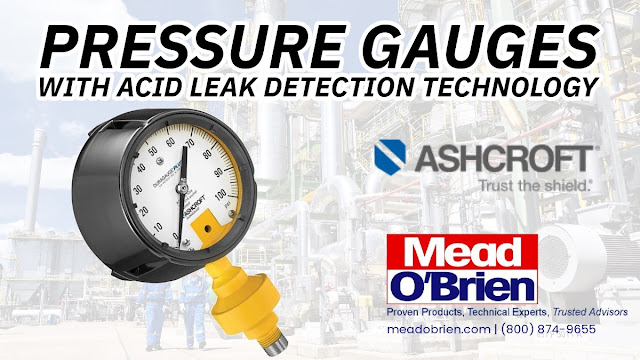In the chemical manufacturing and processing world, the instrumentation and tools used in the industry need to be of the highest quality and withstand harsh operating conditions. These instruments, which are often directly exposed to chemical processes, must endure exposure to extreme temperatures, corrosive substances, and other aggressive conditions. One of the vital instruments in the chemical industry is the industrial pressure gauge, a device used to measure and monitor the pressure of fluids and gases in pipelines, vessels, and other industrial systems. Given the significance of accurate pressure measurement, integrating acid leak detection (ALD) technology into these pressure gauges has become increasingly important. Acid leak detection assemblies offer a valuable tool for industry professionals, providing a visual indication of changes in process media, as they utilize a special coating that changes color when exposed to compounds with pH levels of ≤3.0.
Need for Acid Leak Detection in Pressure Gauges
Industrial pressure gauges are vital for monitoring and controlling processes in various industries, particularly the chemical industry, where accurate pressure readings ensure product quality, safety, and compliance with regulations. As many chemical processes involve acidic substances, a leak of corrosive acids can have serious consequences. Not only can it damage equipment and result in costly downtime, but it can also pose serious safety risks to workers and the environment.
Acid leak detection technology plays an essential role in mitigating these risks. By incorporating this technology into industrial pressure gauges, it is possible to quickly detect leaks of acidic compounds and take appropriate action to prevent damage and ensure safety.
How ALD Technology Works in Pressure Gauges
The ALD technology is a special coating applied to parts of the pressure gauge that might come in contact with the process media in the event of a leak. This coating changes color when exposed to compounds with pH levels of ≤3.0, making it an effective tool for detecting acidic leaks.
The color change in the coating is usually irreversible, which allows for easy identification of leaks even after the fact. Once the gauge shows evidence of a color change, it indicates that an acid leak has occurred, and maintenance personnel can take appropriate measures to address the issue.
Pressure gauges equipped with ALD technology are installed in critical areas of chemical plants, refineries, and other industrial facilities with a high potential for acid leaks.
They monitor pressure in pipelines, tanks, reactors, and other equipment where corrosive substances are processed or stored.
Advantages of ALD Technology in Pressure Gauges
- Early Detection: ALD technology allows for the early detection of acid leaks, preventing further damage to equipment and reducing the risk of accidents.
- Visual Indication: The color change clearly indicates a leak, making it easier for operators to identify the issue and take corrective action.
- Enhanced Safety: By detecting leaks early, ALD technology helps to improve the safety of workers and the environment.
- Cost Savings: Early detection of acid leaks can reduce downtime and repair costs, leading to cost savings for the facility.
Conclusion
Incorporating acid leak detection technology into industrial pressure gauges is an effective way to enhance the safety and efficiency of chemical processes. The ALD technology visually indicates changes in process media, helping operators quickly identify and address leaks of acidic compounds. This technology not only improves the facility's overall safety but also reduces the risk of costly equipment damage and downtime.
Mead O'Brien
https://meadobrien.com
(800) 874-9655






